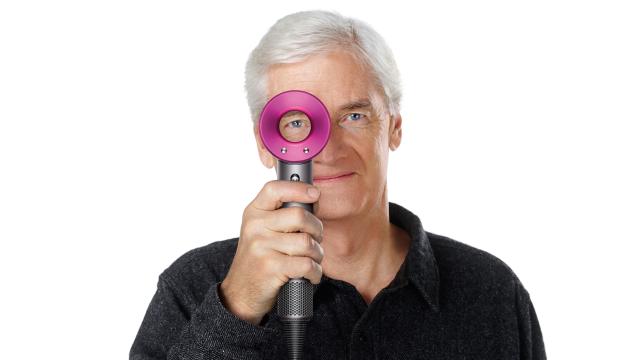“Hey Tegan can you cut some of my hair off for me, I need to send it to Dyson.”
This is a normal day at Gizmodo. And before you ask – Sir James isn’t cloning me. He’s welcome to, though – I do have a bunch of emails to get through.
It has been two years since Dyson – the British company famous for its vacuum cleaners and Air Multiplier fans – invested almost $95 million, enlisted 103 engineers, built 600 prototypes and finally unleashed the Supersonic hairdryeron the world.
The research that Dyson has made into the development of the Supersonic includes a laboratory dedicated to investigating the science of hair. Dyson engineers studied hair from root to tip, understanding how it reacts to stresses, how to keep it healthy and how to style it.
Since 2012 the company has tested the product on different hair types and built test rigs, which mechanically simulate hair-drying techniques – which can differ around the world. To date, over 1010 miles of real human hair have been used in testing.
And now mine is among them.
So here’s a bit of hair science for you.
Hair is comprised of three layers – the cuticle, the cortex, and the medulla.
The cuticle is the hair’s outermost layer, and has scale-like cells that overlap. These cells work defensively to prevent damage to the hair’s inner structure, and to control water content of hair fibre.
The middle structure includes the cortex which provides strength, colour and texture of the hair.
The innermost structure is the medulla layer which is only present in large thick hairs.
The shingle-like cells of the cuticle layer point toward the ends of the hair. The improper use of tools, heat, excessive manipulation and chemical over-processing can cause damage to the cuticle layer of the hair, weakening the integrity of the hair.
When my hair arrived in London, fragments were prepared for imaging by cutting 1cm long samples from three different areas of the hair; near the root, mid length and the hair tip. The fragments were then mounted on SEM stubs with carbon sticky pads and then gold sputter coated.
Samples were then imaged on the Scanning Electron Microscope (SEM) using Back Scatter Electron (BSE) imaging for evaluation.
But what actually goes down at Dyson’s lab?
Heat damage is something the hair care industry has developed thousands of products to combat – from ceramic plating on styling tools to protective serums and creams. None really address the root cause of the problem though, which is the high temperatures these styling tools reach, and the fact they are coming in direct contact with your hair.
This was a problem Dyson was keen to solve. The result? 20 times a second, the Supersonic measures its temperature output, transmitting data to a microprocessor which in turn controls the heating element, avoiding the risk of burns and heat damage.
Scientists are using advanced scanning electron microscopes to look at single strands of human hair in high definition after testing – to understand the structure of hair and which elements cause splits, holes and other damage.
They use a tensile test to measure the strength and elasticity of each hair strand before and after drying and styling, by stretching the strand until it breaks. Healthy hair remains strong and elastic whilst damaged hair is easier to break.
Thermal cameras let the engineers can understand the temperature of the airflow coming out of the machine – making sure it is consistent throughout, even when pushed close to your head or to a brush.
The Real Imaging Test Algorithm machine, or RITA, gives researchers a range of image settings specifically designed to highlight key hair tress characteristics and features such as strand alignment, flyaways and frizz.
Finally, Particle Image Velocimetry (PIV) meant that Dyson engineers could measure the speed of the jet and visualize its shape, getting a much deeper understanding of the jet structure and turbulence within. This was all so they could optimise the airflow, and influenced the development of three precisely engineered magnetic attachments.
But you know what else they can do? Validate my borderline obsession with their ridiculously priced hairdryer. You see, I’ve been using it since launch, convincing my friends to buy them, the works. You’d think I’m getting commissions the way I won’t shut up about how good this thing is.
“This hair is a very healthy hair. Cuticle scales extend from root to tip and are in an above average condition.
They show minimal breakage and lifting.”
Two years of the Supersonic, and my hair is healthy AF – even at the end, where it should be a damaged mess.
That’s gotta be worth the price tag. Right?
